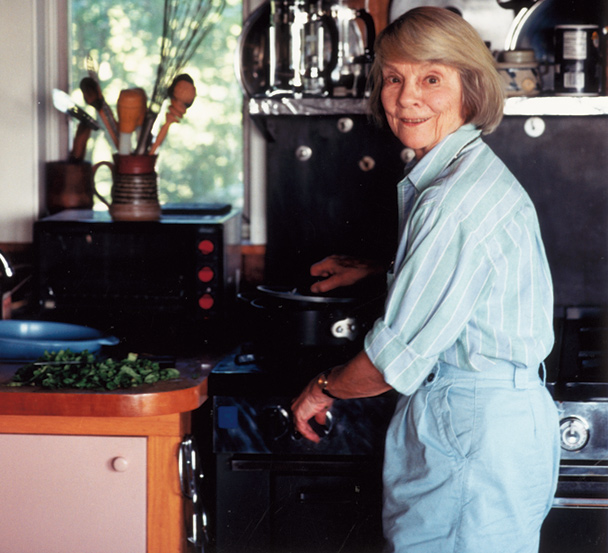What makes a classic dish? I’m sure interpretations would vary greatly, particularly today when so many liberties are being taken by creative chefs eager to forge a new cuisine.
I had this discussion long ago with Julia Child when I was trying to write persuasive jacket copy to convince American home cooks that in order to master the art of cooking, they had to start by learning the basics of French cuisine. Why French, I asked her, and her firm answer was that only French dishes are codified; they are the foundation on which Western cuisine was built.
To Julia, a classic would be a master recipe that utilized time-honored techniques. Once these were understood and mastered, the techniques could be allied to an infinite number of dishes that were essentially variations on the theme. In fact, she went as far as to say that once these essential recipes and techniques were imprinted on our brains, we wouldn’t even need a cookbook. We could do anything.
Julia’s mission—and it was a mission—was to teach these fundamentals to the American home cook, who had been brainwashed by the food industry into regarding cooking as demeaning to the liberated 20th-century woman. But once the postwar generation was exposed through European travel to the delights of good cooking, there was no turning back. “Fast and easy” was no longer the goal. Moreover, it was fun to get it right, and Julia empowered us.
Take, for example, all we can learn from what has become an iconic recipe for a classic, boeuf bourguignon as it appeared in Mastering the Art of French Cooking:- What the best cuts of meat are for braising
- How to simulate French lardons by blanching American bacon
- Why it is important to dry the meat first and not crowd the pan so the meat browns, not steams
- What kind of fat to use when butter alone will burn at a high temperature
- Not to cheat on the wine (it should be as good as what you serve with your meal)
- The importance of cooking the mushrooms and the baby onions separately to get a good glaze that enriches the sauce
- Steps to do ahead
- Suggestions for serving
Above all, when we do a classic recipe carefully, we learn how to observe, to taste, to smell, even to listen, and then adjust the seasonings. The classic dish sets the standard, and because we have tasted and appreciated it in our travels or at a fine restaurant, we know what we are aiming for. It may be more challenging with cuisines we may not have had as much access to, such as Chinese or Indian, because in that case we are flying blind, often not having tasted a dish we are trying to reproduce. More than ever, an articulate and inspiring recipe writer is needed to empower us.
I remember when I first started working with Lidia Bastianich, watching her prepare a quick pan sauce while her pasta was cooking. After she had sautéed the aromatic vegetables, she pushed them aside, and in a dry spot in the hot pan she plopped a large spoonful of tomato paste, scraping it around so that it didn’t stick to the bottom as it cooked. I asked her why she did that, and she said simply that frying the paste intensified its flavor. Something clicked, and I remembered Madhur Jaffrey using a similar technique in several Indian dishes, first puréeing the spices and aromatics in the blender to make a paste and then frying the paste in a dry, hot pan. It seemed at the time a strange procedure—frying a paste? But it made me realize how classic techniques are often connected and that what makes a dish classic lies primarily in how it is done with finesse.
When Julia was in her early 90s, she and I were asked to do an evening of conversation at the St. Johnsbury Athenaeum in northern Vermont, close to where I spend summers. When word got out that Julia was making an appearance, the response was so enthusiastic that they had to move us from the Athenaeum library to the large high school auditorium, and it was packed. One of the questions someone asked was how Julia would define what makes good French cooking. Swinging a slacks-clad leg, she leaned back in her chair on the stage and described cooking green beans: carefully tailing and topping them; dropping them into a very large pot of boiling, salted water (you could take your vitamins in a pill, she said as an aside, dismissing newfangled notions of so-called more nutritious preparations); draining the beans when they are just done à point (“not crunchily underdone,” she added); then plunging them into ice water to set the color; and finally, after draining again, warming and bathing them in plenty of butter. That is French cooking, soigné cooking, she sighed.
So let’s put away our sous-vide and other contrivances to create a molecular cuisine and instead fill the kitchen with good cooking smells and enjoy the pleasures of making one of the great classics.
Judith Jones has made an unparalleled contribution to the great cookbooks of our time by discovering, closely collaborating with, and publishing Julia Child (Mastering the Art of French Cooking and subsequent titles), Lidia Bastianich, Madhur Jaffrey, Jacques Pépin, Marcella Hazan, and many other masters. Newly retired from a half century at Knopf, she is the author, in recent years, of The Pleasures of Cooking for One and The Tenth Muse.



 Pinterest
Pinterest


